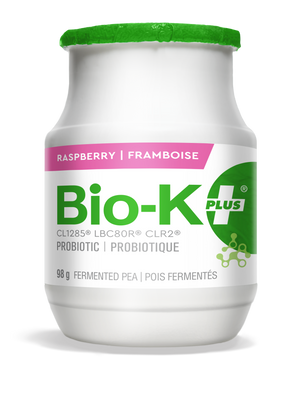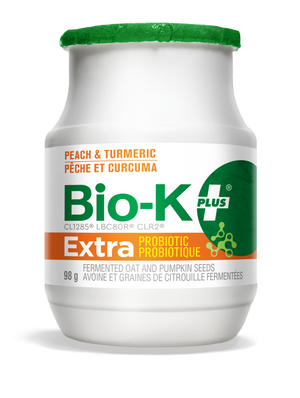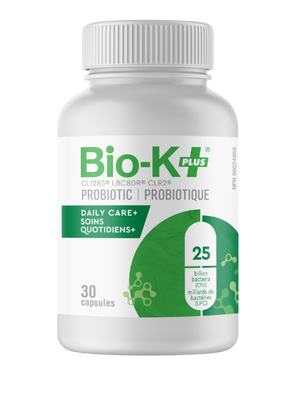Do Cleaning Products Alter the Gut Microbiome?
Kills 99% of germs. Sounds pretty good, right, especially when we are trying to disinfect our countertops and keep loved ones from getting ill, but did you ever stop to ask yourself if 99% of those germs really need to be killed?
When it comes to the health of our microbiome, cleaner isn’t always better. The personal care and cleaning products we use to clean our homes and body can contain some pretty nasty chemicals that have been linked to cancer, asthma and allergy.1
Many of us have the understanding that when we take an antibiotic, it doesn’t discriminate between good bacteria and bad (why taking your daily probiotic is so important!) but we don’t question it when it comes to the antibacterial promises that our cleaning products make.
What effect do cleaning products have on the health of our microbiome?
Triclosan & The Microbiome
Triclosan is an antibacterial compound found in deodorants, antiperspirants, soaps, laundry detergents, toothpaste and hand sanitizers. Triclosan is also used as an ingredient to prevent bacteria, fungus, mildew and odours in other household products that are advertised as “anti-bacterial”.2
Triclosan can be absorbed through the skin and is currently believed to interfere with hormones, especially the thyroid, disrupting their normal functioning.2,3
Presently, Health Canada limits the amount of triclosan that is allowed in personal care products, stating that at low levels there is no harm to Canadians. The issue, however, is the number of products that triclosan is found in adds up over the course of our day. Further to that antibacterial hand soaps (as an example) are not categorized as a ‘cosmetic’, allowing the amount of triclosan in these products to potentially be higher.2
Looking more specifically at the effect of triclosan on the microbiome, one study looked at the impact that low-dose exposure to triclosan, in combination with two other chemicals (diethyl phthalate (DEP), methylparaben (MPB)) would have on the microbiome of rats. Versus the control group, adolescent rats that had low-dose exposure (similar to human levels) showed significant changes in overall bacterial composition.4
Another study looking at zebrafish found similar results. When fed a triclosan-laden food the structure and communities of the gut microbes changed. The researchers also noted alterations to microbial interaction networks, resulting in more negative interactions per microbe. As such it was concluded that exposure to triclosan could result in altered composition and dynamics of the microbiome.5
The Hygiene Hypothesis
First proposed in 1989, the ‘Hygiene Hypothesis’ is the idea that the decline in our exposure to microbes, due to clean water and food, sanitization, antibiotics, harsh environmental cleaning products, urban living and birth practices is a significant factor in the increasing prevalence of atopic diseases like dermatitis, allergy, and asthma.6
To be clear, a lot of these practices, like clean drinking water and access to antibiotics are a benefit to society and keep us safe from infectious disease, but it is our reduced to exposure to non-pathogenic strains (commensals or environmental strains), and components of microbes such as bacteria endotoxins that have researchers taking note.
Researchers looking at the gut microbiome of children with allergy versus without, noted that the intestinal flora of allergic children showed the presence of aerobic bacteria, coliforms and Staphylococcus, while children without showed the presence of Lactobacilli and Bifidobacteria spp.6 It is believed that these latter bacteria species prime our immune system, and protect our gut mucosal integrity, which in turn help prevent atopic diseases and other immune-related conditions.6
To Clean or Not to Clean
What researchers have pointed out is that we need to better understand the difference between ‘dirt’ and ‘germs’, ‘cleanliness’ and ‘hygiene’. The WHO refers to ‘hygiene’ as the conditions and practices that help maintain health and prevent the spread of disease; While there is no denying that cleanliness is a part of this, taking it too far can potentially have the reverse effect on our health and well-being.
If exposure to a certain number (and array) of microbes is good for us, then it would be wise to reduce the use of harsh chemicals that destroy not only virulent bugs but non-pathogenic strains as well and increase our exposure to a diverse number of microbes to support a healthy microbiome.
Here are some tips to get you on your way:
Reduce the Use of Harsh Cleaners in Your Home
Don’t be fooled though by ‘Green’ claims on packaging. Often these can be misleading or more marketing driven than based on science. Visit trusted sites like Environmental Working Group or David Suzuki to get a better understanding of how ‘green’ your cleaning and personal care products really are, and natural alternatives that might be a better fit for you, your home (and the environment).
Get Outside into Nature
People who live in the country tend to have more diverse microbes that city dwellers, but that doesn’t mean all is lost for urbanites! Get your hands dirty, garden, visit a farm, pet an animal, play outside to increase your exposure to different types of bacteria.
Eat, Drink and Be Merry
We know that a healthy gut microbiome loves lots of colourful, plant-based foods. Increase your exposure to even more gut-friendly bacteria, by consuming probiotics and fermented foods like drinkable Bio-K+ that has three unique and clinically-proven strains of Lactobacillus bacteria in every bottle.
Skip the Antimicrobial Hand Sanitizer & Just Use Soap and Water
While you might resort to hand sanitizer in a pinch, whenever possible just use soap and water to clean dirty hands. Be sure to skip any ‘anti-bacterial’ soap that will most likely include triclosan as part of its ingredients list.
A healthy gut is a diverse gut. If you have more questions on improving the health of your microbiome let us know in the comments below. Join our community for more healthy tips. Click here to find a store near you. Contact us or follow us on Facebook and Instagram.
References
1. https://www.ewg.org/guides/cleaners/content/cleaners_and_health#.W4_pLZNKjBI
2. https://davidsuzuki.org/queen-of-green/dirty-dozen-triclosan/
3. https://www.ewg.org/guides/cleaners/content/cleaners_and_health#.W4_pLZNKjBI
6. Too clean, or not too clean: the Hygiene Hypothesis and home hygiene - PMC (nih.gov)





